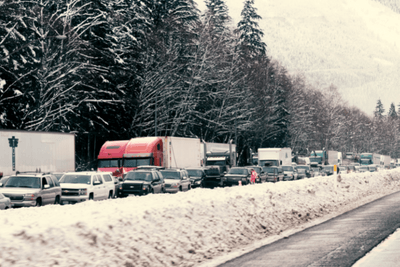Winter’s Dangerous Grip- Preparing for Severe Weather

Table of Contents
Winter weather has already hit portions of the United States.
Midland Radio's Meteorologist, Bruce Jones shares his tips for preparing ahead of severe winter weather.
What’s America’s #1 weather killer? Heat. Most years heat and heat-related illnesses kill more people than floods, tornadoes and hurricanes combined. But what is America’s biggest weather pain-in-the-rear? Winter storms, by far.
WINTER WEATHER
Blizzards, ice storms, extreme cold, and “nor’easters” produce havoc that damages homes, schools, cars, power lines, highways, agriculture, airlines, trains, livestock, and factories to the tune of millions of dollars.
Deaths are caused by traffic accidents, heart attacks while shoveling snow, and carbon monoxide poisoning when portable gasoline-powered generators are used improperly. Some people simply freeze to death.
GETTING AHEAD OF THE STORM
The National Weather Service issues Blizzard Warnings, Winter Storm Warnings, Ice Storm Warnings, Windchill Warnings, and Snow Squall Warnings to alert people to the dangers of cold, ice and snow, but ours is a very mobile society, and businesses and agriculture are always active. The conflict of daily human responsibilities and cold weather can create monumental problems. Here are some examples:
- Heavy snow or a coating of solid ice can keep eighteen-wheel trucks from getting through on even the best maintained highways. Factories operating via “just in time manufacturing” need component parts to arrive every day, on schedule. An automobile plant that doesn’t receive one or two truckloads of parts may have to shut down, costing the company millions of dollars in lost productivity.
- Blizzards or extremely cold windchills can kill herds of cattle, especially late winter or early spring events that develop rapidly, strike with a vengeance, and quickly wipe out newborn calves. Large losses of cattle or devastating freeze damage in fruit and vegetable orchards can drive producers into bankruptcy. It only takes one storm.
- Churned by powerful low pressure areas in the ocean off New England, “nor’easter” storms produce hurricane-force northeast winds, destructive waves and surf, coastal flooding, and huge dumps of inland snow. Shipping, high speed passenger trains, airports and highways can all be affected. 1991’s “Perfect Storm” was a deadly example.
- In late fall or early winter, before the Great Lakes freeze over, their liquid surfaces provide a rich moisture supply for cold arctic air to produce “lake effect” snow showers. Thunderstorm-like squalls move ashore in Ohio, New York and Pennsylvania, dropping enormous amounts of snow in mere minutes and creating total whiteout conditions within one mile. Snow falls heaviest nearest the unfrozen lake, where unsuspecting motorists can get stranded in deep snow or caught up in deadly chain reaction accidents during whiteouts.

Photo courtesy: National Weather Service
PROTECTING YOURSELF
How can you protect yourself from dangerous winter weather?
The most important thing is to stay home and off the roads when a Winter Storm Warning, Blizzard Warning, or Ice Storm Warning is issued.
LOOKING BACK
On the Pennsylvania Turnpike in 2016 more than 500 vehicles became stranded when eighteen-wheelers got stuck on an uphill climb, paralyzing traffic along 50 miles of highway.
For the next two days hundreds of cars, trucks, and passenger busses sat motionless in deep snow as Pennsylvania Highway Patrol officers and National Guard troops braved horrific conditions to reach them.
Up to two feet of snow had been forecasted for the area, but drivers either didn’t hear the forecast, or tried to beat the storm.
In the course of their two-day ordeal, you can bet the poor folks forced to use trees and bushes for numbingly-cold potty relief dreaded their decisions!

Photo courtesy: National Weather Service
NOAA WEATHER RADIOS
To make sure you always know the weather predictions for your area and the places you’re headed, check the forecast before you leave home, and have a NOAA Weather Radio in your car.
As the official “Voice of the National Weather Service”, the NOAA broadcast delivers the latest life-saving information direct from its source.
Midland’s ER40 Emergency Crank Radio is perfect for winter travel, bringing you AM/FM news reports and NOAA Weather Radio alerts.
The dynamo crank allows you to recharge the radio, its flashlight, and your cell phone. Use the flashlight’s SOS blinker to signal for help.
SAFETY KIT
Finally, if you must travel, be prepared with a winter safety kit in the trunk of your car.
Sand (or kitty litter) helps slipping tires gain traction.
Blankets, winter gloves, snack foods, and water offer welcome relief when stuck in snow, and an old decorative candle or two (with matches) can produce enough heat to keep you and your passengers from freezing.
I have successfully extricated my car from a ditch using a small plastic emergency snow shovel, so I can assure you: those things really work!
For more winter weather safety tips, head here.




